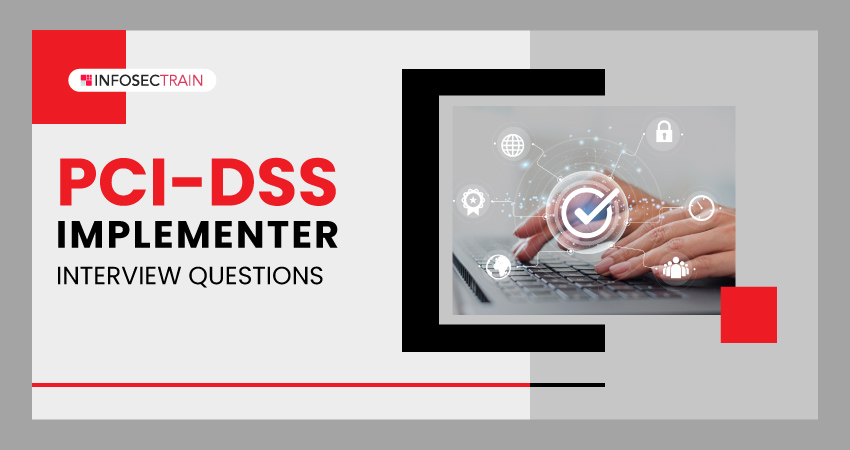PCI-DSS Implementer Interview Questions
A PCI-DSS Implementer is a professional or individual responsible for implementing and ensuring compliance with an organization’s Payment Card Industry Data Security Standard (PCI-DSS). They know the PCI-DSS’s requirements and best practices and maintain the organization’s security controls and processes to protect cardholder data.

To become a successful PCI-DSS Implementer and demonstrate your knowledge, skills, and expertise in implementing and maintaining PCI-DSS compliance within an organization, you need to familiarize yourself with common interview questions. In this article, we will go over the commonly asked PCI DSS interview questions and answers to become a PCI-DSS Implementer and enable you to crack the interview.
Top interview questions
1. Define PCI-DSS.
PCI-DSS (Payment Card Industry Data Security Standard) is a set of security standards designed to safeguard cardholder data and promote secure payment card transactions.
2. Why is PCI-DSS important in the payment card industry?
PCI-DSS is important in the payment card industry as it provides a standardized framework to protect cardholder data, ensuring customer trust, reducing fraud risks, and maintaining the integrity of the payment card ecosystem.
3. What are the PCI-DSS requirements?
There are 12 PCI-DSS requirements, including:
- In order to safeguard cardholder data, install and maintain a firewall.
- For system passwords and other security settings, never use vendor-supplied defaults.
- Keep cardholder data secure.
- Transmit cardholder data across open, public networks using encryption.
- Use antivirus software or programs and regularly update them.
- Develop and maintain secure software and systems.
- Restrict access to cardholder data for those who need to know.
- Every person with computer access should have a unique ID.
- Restrict physical access to cardholder data.
- Track and monitor every network resource and cardholder data access.
- Test security systems and processes regularly.
- Keep an information security policy for all personnel.
4. What are the steps involved in scoping a project for PCI-DSS compliance?
Scoping a PCI-DSS compliance project involves:
- Identify the systems, processes, and people involved in storing, processing, or transmitting cardholder data.
- Determine the boundaries of the Cardholder Data Environment (CDE).
- Define the scope of the compliance project based on the CDE.
- Document the scope, including in-scope systems, networks, and third-party connections.
- Ensure accurate and up-to-date documentation throughout the scoping process.
5. What are the different types of sensitive data covered by PCI-DSS?
Here are the different types of sensitive data covered by PCI-DSS:
- Primary Account Number (PAN)
- Cardholder Name
- Expiration Date
- Service Code
- Sensitive Authentication Data (SAD)
6. What are some standard security controls used to protect cardholder data?
Some standard security controls used to protect cardholder data include:
- Encryption
- Access controls
- Firewalls
- Vulnerability management
- Logging and monitoring
- Physical security
- Security awareness training
- Secure coding practices
- Incident response
7. How many PCI-DSS compliance levels are there?
There are four levels of PCI-DSS compliance:
- SAQ A
- SAQ B
- SAQ C
- SAQ D
8. What are the advantages of PCI-DSS compliance?
The advantages of being PCI-DSS compliant include the following:
- Enhanced security posture
- Reduced risk of data breaches
- Increased customer trust
- Protection of cardholder data
- Avoidance of financial penalties and reputational damage
9. In a PCI-DSS environment, what requirements exist for logging and monitoring?
Logging and monitoring requirements in a PCI-DSS environment include:
- Maintaining detailed audit logs
- Implementing time synchronization
- Reviewing logs daily
- Generating alerts for critical events
- Retaining logs for a specified duration
10. What are some common PCI-DSS compliance security risks?
Some common PCI-DSS compliance security risks include:
- Weak passwords
- Unpatched systems
- Unauthorized access
- Inadequate network segmentation
- Lack of encryption
- Improper handling of cardholder data
11. What are a PCI-DSS environment’s primary requirements for physical security?
Key requirements for physical security in a PCI-DSS environment include restricted access to sensitive areas, video surveillance, visitor logs, and proper disposal of cardholder data.
12. What does a firewall do in a PCI-DSS environment?
A firewall in a PCI-DSS environment protects cardholder data by controlling and monitoring network traffic, preventing unauthorized access.
13. What challenges come with adhering to PCI-DSS compliance?
Some challenges of being PCI-DSS compliant include the following:
- Complexity of requirements
- Ongoing maintenance
- Resource and cost implications
- Staying up to date with evolving standards
- Managing compliance across multiple systems and locations
14. What are the key components of a Cardholder Data Environment (CDE)?
The critical components of a Cardholder Data Environment (CDE) include systems and networks that store, process, or transmit cardholder data, along with any connected systems that affect the security of the CDE.
15. What are the types of PCI-DSS reports?
There are several types of PCI-DSS reports that organizations may encounter during the compliance process. Here are the main types of PCI-DSS reports:
- Report on Compliance (ROC)
- Attestation of Compliance (AOC)
- Self-Assessment Questionnaire (SAQ)
- Quarterly scan report
- Penetration testing report
- Compliance attestation
16. What process is followed in a PCI-DSS environment to find and document vulnerabilities?
The process for identifying and documenting vulnerabilities in a PCI-DSS environment typically involves the following steps:
- Conduct regular vulnerability scans using approved scanning tools.
- Analyze scan results to identify vulnerabilities and prioritize them based on severity.
- Document identified vulnerabilities along with their risk ratings and potential impact on cardholder data.
- Assess each vulnerability’s root cause and impact to determine appropriate remediation steps.
- Develop a plan to address and remediate identified vulnerabilities.
- Implement necessary security controls and patches to mitigate vulnerabilities.
- Document the actions taken to remediate vulnerabilities and ensure they are properly tracked.
- Conduct regular follow-up scans to verify the effectiveness of remediation efforts.
- Maintain a comprehensive record of vulnerability assessments, remediation activities, and ongoing monitoring efforts.
- Regularly review and update vulnerability management processes to adapt to emerging threats and technology changes.
17. What are the payment card data’s common security vulnerabilities or risks?
Common security vulnerabilities or risks associated with payment card data include weak passwords, unpatched systems, insecure remote access, network breaches, social engineering, inadequate encryption, network insecurities, and human error or insider threats.
18. How to ensure that an organization is compliant with PCI-DSS?
There are several ways to ensure that an organization is compliant with PCI-DSS. These include:
- Conducting a security assessment
- Implementing security controls
- Monitoring and testing security controls
- Maintaining a security policy
- Training employees on security
19. What are the latest trends in PCI-DSS compliance?
Some of the latest trends in PCI-DSS compliance include an increased focus on the following:
- Cloud environments security
- Third-party risk management
- Emerging technologies like mobile payments and IoT
- Adoption of tokenization and encryption technologies
- Evolving compliance requirements
- Risk assessments
- Security awareness training
20. What are the most important factors for secure remote access in a PCI-DSS environment?
The most important factors for secure remote access in a PCI-DSS environment include strong authentication, endpoint security, encrypted connections, access control, multi-factor authentication, and monitoring or logging of remote access activities.
In a competitive job market, being well-prepared with interview questions gives you an advantage over other candidates, highlighting your dedication to the role and commitment to compliance and security.
Related Blogs:
- Top PCI-DSS Interview Questions
- Roadmap To Achieving The PCI-DSS Certification
- All About PCI-DSS Training with InfosecTrain
- PCI DSS Scenario-Based Interview Questions
How can InfosecTrain help?
Enroll in InfosecTrain‘s Payment Card Industry Data Security Standard (PCI-DSS) training course to gain in-depth knowledge and practical skills to effectively implement and maintain PCI-DSS compliance within your organization. We help participants understand the intricacies of PCI-DSS and how to apply it in their specific environment. We ensure that participants receive up-to-date and reliable information, benefit from experienced instructors, and have access to relevant resources and support throughout their learning journey.
TRAINING CALENDAR of Upcoming Batches For PCI DSS
| Start Date | End Date | Start - End Time | Batch Type | Training Mode | Batch Status | |
|---|---|---|---|---|---|---|
| 16-Aug-2025 | 31-Aug-2025 | 19:00 - 23:00 IST | Weekend | Online | [ Open ] |







 1800-843-7890 (India)
1800-843-7890 (India)